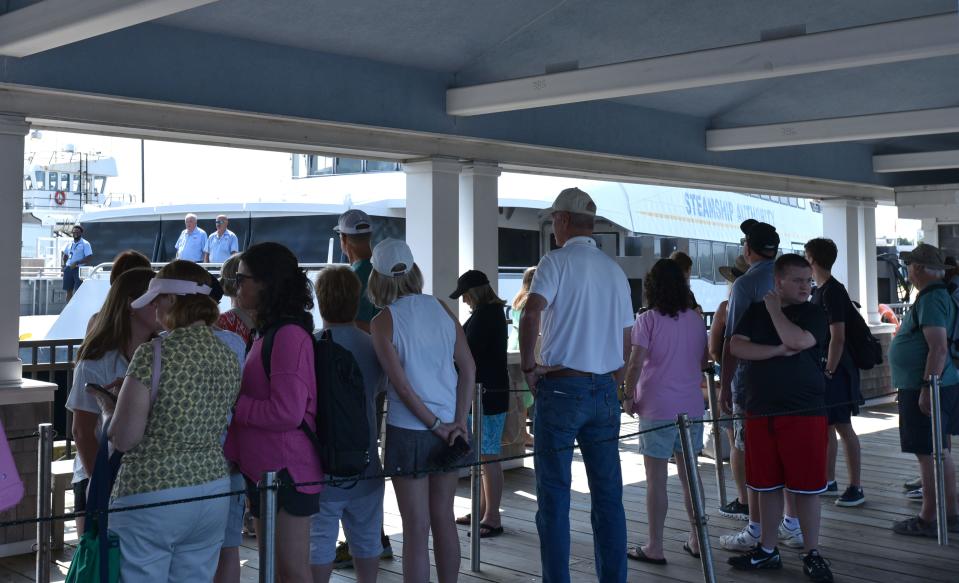Population growth during COVID cited in Steamship Authority rider, revenue increases
Cars, trucks, bicyclists and pedestrians have returned to pre-COVID numbers on the Woods Hole, Martha’s Vineyard and Nantucket Steamship Authority ferries, according to the agency's latest annual report.
Overall passenger and vehicular ridership has increased along with the authority’s revenue and operating and maintenance costs, according to the report.
“I think to some extent we are back to business as usual,” Peter Jeffrey, Steamship Authority board member from Falmouth, said Tuesday.

Passenger ridership increased by 6.5% from 2021, with around 2.9 million passengers in 2022, according to the report. Operating revenue increased by 2.3% from 2021, and a 5.6% increase was seen in the costs of operating and maintaining vessels.
Operating revenues totaled about $131 million in 2022, which the report stated was an increase of nearly $2.9 million from 2021.
Of the total operating revenues for 2022, automobile revenues represented the largest category, at approximately 32%, then passenger ridership. Freight travel, parking fees and other sources brought in revenue as well.
“It was sort of a water returning to level year for us,” said the authority's communication director, Sean Driscoll, on Tuesday. “Although we didn't quite get to a true pre-pandemic year, it’s closer than we had been certainly in several years.”
What is the Woods Hole, Martha’s Vineyard and Nantucket Steamship Authority?
The Steamship Authority is a ferry operating service that provides trips to and from the Cape to Nantucket and Martha’s Vineyard for passengers as well as vehicles — from cars to large freight-carrying trucks. The Authority has terminals in both Hyannis, which ferries passengers to Nantucket, and Woods Hole, which operates ferries to and from the Vineyard.
The Massachusetts Legislature created the Steamship Authority in 1960 to provide for “adequate transportation of persons and necessaries of life for the Islands of Nantucket and Martha's Vineyard.”
Another ferry option for the Cape and Islands is the privately-owned Hy-Line Cruises, which offers residents and visitors a passenger-only ferry service.
In 2010, the Steamship Authority carried about 2.7 million passengers and 438,515 automobiles to Martha’s Vineyard and Nantucket. Almost 10 years later in 2019, right before the pandemic, the Authority transported about 3 million passengers and 478,990 automobiles to the Vineyard and Nantucket.

In 2020, a recent low point which saw the number of trips reduced, the number of passengers dipped to 963,7831 and cars to 201,407.
The increased ridership could be related to how Island populations grew during COVID
Jeffrey said the increase in ridership and revenues could be a result of population increases on the Cape and Islands.
It may be “business as usual” for 2022, Jeffrey said. “But both islands’ year-round populations grew extensively during COVID."

On Nantucket, the population in 2020 was around 14,251 residents, according to the U.S. Census. In 2022, the census showed that figure grew to 14,421. And on Martha’s Vineyard, census figures showed the population increased from 20,595 in 2020 to 20,868 in 2022.
In Barnstable County, which covers the entire Cape, the population increased from 229,004 in 2020 to 232,457 in 2022, according to the census.
And while ticket prices vary between the offseason and summer months, hauling cars and trucks costs more than carrying passengers. The price to transport an average-sized SUV or sedan to Nantucket on a summer weekend is $590, compared to $345 for the offseason — and for the Vineyard, the price for a car for a summer weekend is $250 and the offseason is $128.
Adults passenger fares are $20 to $81 depending on which island and which service — the high-speed Nantucket service or the traditional services to each island.
Vessel replacement one of two major projects
Robert Ranney, the Steamship Authority Board Chair from Nantucket, said the Steamship Authority doesn’t receive funding from the state aside from a few grants and other methods of funding, so replacing vessels and the Woods Hole terminal reconstruction — two major projects detailed in the report — are significant.
“The Steamship Authority is almost completely self-funded by the ridership,” Ranney said. “So, it's difficult to do things like big projects because there's not a lot of extra money.”
Operating expenses totaled about $120 million, an increase of approximately $6 million from 2021, the 2022 report found. Maintenance expenses increased by nearly $2.3 million.
Three new vessels joined the Steamship Authority fleet in 2022, according to the report. The three identical offshore supply vessels were purchased from Hornbeck Offshore Services. The vessels will be primarily used to transport automobiles and freight.
“This is obviously part of our vessel improvement plan, and bringing on three new vessels at once like this is a very rare opportunity,” Driscoll said. “They're open deck freight vessels with lower passenger counts, lower passenger capacity than the big boats.”
More: Third of Steamship Authority's fleet approaching the end of their lifespan
All three will go towards the replacement of the M/V Katama, the M/V Gay Head and the M/V Sankaty, Driscoll said.
The Steamship Authority is concerned over the “remaining useful life” of the M/V Katama and M/V Gay Head were a citing the vessels' age and maintenance costs, the report said.
Bigger cars and trucks require bigger boats, according to the Steamship Authority
“They're not obsolete, per se, but vehicles have gotten bigger, cars have gotten bigger,” Ranney said, referring to the current ships the vessels are replacing. “Squeezing vehicles onto the existing boats, it becomes challenging, trucks are bigger than they were 30 or 40 years ago, ridership has increased. All that stuff goes into looking at vessel replacement.”
Although the three offshore supply vessels will replace the M/V Katama, M/V Gay Head and M/V Sankaty, Driscoll said whether all three will be retired remains to be determined.
The average age of the Steamship Authority’s fleet is 34 years old, with the M/V Governor being the oldest vessel — clocking in at about 69 years old — and the M/V Woods Hole having been commissioned in 2016, according to the Steamship Authority’s website.
A fourth vessel may be purchased this year, the report stated. Driscoll said the private offshore service company, Hornbeck, is marketing another offshore supply vessel for sale but has not yet made anything final.
Woods Hole terminal reconstruction underway
The Woods Hole terminal reconstruction project, set to be a net-zero energy facility, saw the completion of the installation of a stormwater system and the drilling of geothermal wells that will be used to heat the terminal, according to the report.
The next phase will see the construction of the new terminal building, a new utility building, and a new employee parking lot with a solar panel canopy structure.
Waterside construction wrapped up in 2022 with the completion of the barge slip, slip No. 1. New passenger loading walkways, ramps and an outer floating passenger platform were completed along with the barge slip.
The entire project is estimated to cost about $110 million, and Driscoll said the next phase of construction will begin later in the fall.
“All of our construction is done in the offseason to minimize the impacts on the busy season,” Driscoll said. “We haven't awarded the bid for the work yet, so we don’t have a start date.”
Walker Armstrong reports on all things transportation and the Joint Base Cape Cod military base. Contact him at WArmstrong@gannett.com. Follow him on Twitter: @jd__walker.
Thanks to our subscribers, who help make this coverage possible. If you are not a subscriber, please consider supporting quality local journalism with a Cape Cod Times subscription. Here are our subscription plans.
This article originally appeared on Aberdeen News: At Steamship Authority revenue, expenses increased in 2022, 3M riders

